 PowerPoint Topic 4
PowerPoint Topic 4
Working with Objects
Insert Information using Text boxes, Drawing Tools and AutoShapes :
Text box - a box that holds slide text where you type and later format to modify the text style.
Drawing Tools - graphics-related tools to insert art and draw pictures inside your slides, easy to use and show themselves (along with their toolbars) when you request them :

AutoShapes - inserts one of the ready-made shape, which you can manipulate such as resize, rotate, flip, colour, and combine with other shapes eg. lines, Basic shapes, Flowchart, Stars and Banners etc.
In
addition to meaningful text, an effective presentation also includes
shapes and pictures that complement and enhance the message.
Sometimes, you may need to format your presentations (modify
individual slides when needed) by mastering
PowerPoint design and editing tools, for example :
Slide
Layout
- a single slide's format and design.
Click
<Insert>
<New Slide>

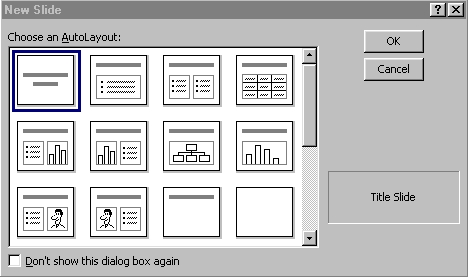
Select
<Blank
AutoLayout>
Drawing and Modify a Shape
PowerPoint comes with a set of ready-made Autoshapes that you can insert into a document. Autoshapes include complex shapes, block arrows, flowchart symbols, stars and banners, and callout ballons.
The shapes you draw, the pictures you import from other programs, and the text you type are all examples of objects. You can resize, copy, paste, moving, cutting, and deleting are editing commands you can use on any object
Get Drawing Tools :
Menu, Point and click <View><Toolbars> : click Drawing

Click <AutoShapes>
button on the Drawing toolbar
Point to the <Stars And banners> at the Autoshapes menu
Click <Explosion
2> button
You
can use the white squares called Resize handles to size
the object.
Click <Fill
Color> down select orange

Position
the object on the left side of the presentation slide
Click
<AutoShapes>
button on the Drawing toolbar
Point to the <Stars And banners> at the Autoshapes menu
Click <Curved
Down Ribbon> button
You
can use the white squares called Resize handles to size
the object.
Click <Fill
Color> down select dark blue

Position
the object on the right side of the presentation slide
Click
<Free
Rotate> button on the Drawing toolbar
Click the top-left rotate handle and drag it up

Click
<Insert>
<New Slide>


Select
<Blank
AutoLayout>
Select the
Arrow object
Drag Resize
handle to the right.
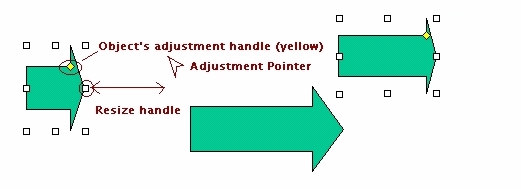
Drag Object's
adjustment handle (yellow
diamond)
to the right.
Copying and Moving an Object
You can copy or duplicate a selected object or multiple objects to the Windows Clipboard and then paste the objects in other parts of the presentation.
Copy & Paste, Cut & Paste
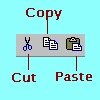
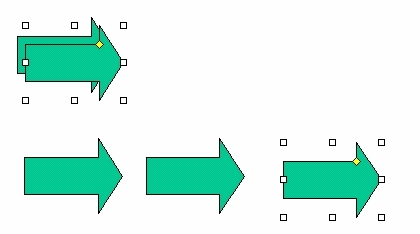
Alternatively
Press <Ctrl> <Click> at the object.
Alternatively Use Clipboard
Menu, Point and click <View><Toolbars> :
click Clipboard

Close <Office Clipboard>
Changing the Shape of an Object
If you created an object using an Autoshape, PowerPoint allows you to change the shape to another shape with one easy command.
Use the Same Slide
<Shift> + Click Select all the arrows objects
Click <Draw> button
Select <Change Autoshape> option
Select <Stars and Banners>
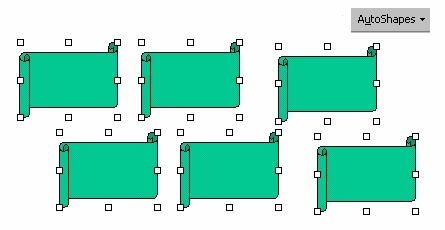
Modify Object Attributes
Objects have attributes that define how they appear on the slide - fill, line, shape, and shadow. The text attributes are style, font, colour, embossment, and shadow.
Click <Insert> <New Slide>


Select <Blank AutoLayout>
Select <Ribbon> object
On the Drawing toolbar,
Click <Fill Color> menu
Select <Fill Effects>
Click <Texture> tab
Click <Blue Tissue Paper textured fill>
(first in the third row)
Click <OK>
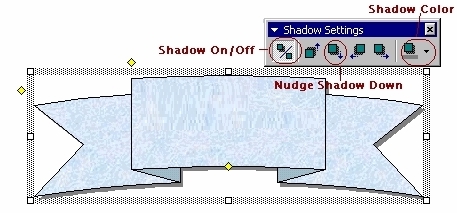
Click <Shadow> button
Select <Shadow Style 6> button
Click <Shadow> button
Click <Shadow Settings> toolbar
Click <Nudge Shadow> down button (x5)
Click <Shadow Color> button
Select <Semitransparent Shadow>
The shadow color changes to semitransparent, which allows the background to show through.
Close <Shadow Settings> toolbar
Aligning Objects
PowerPoint uses two fundamentally different ways of aligning a group of objects : you can align objects to each other, or you can align them to a guide.
<Shift> + Click Select two objects
Click <Draw>
Select <Align Or Distribute>
Click <Align Center>
Alternatively
Click <View> Click <Guides>
Drag the Guides to the left
Click <View> Click <Guides>
Disable the Guides
Adding 3-D Effects to Objects
Once you draw an object, you can change the object to look 3-dimensional.
Click <3-D> button Click <3-D Style 6>
Click <3-D> button Click <3-D Settings>

Click <lighting> button
Click <third Lighting Direction> button
Click <Tilt Left> button (x5)
Click <Depth> button Click <144 pt.>
Close <3-D Settings> toolbar
Laying Objects : Changing Stacking Order
Stacking or layering is the placement of objects one on top of another. The first object you draw is on the bottom, and the last object you draw on top. You can change the placment of the objects by using the Bring To Front, Send To Back, Bring Forward, and Send Backward commands.
Click <Draw> button
Click <Order> Click <Bring To Front>
Rotating and Flipping Objects
Once you create an object, you can change its orientation on the slide by rotating or flipping it. Rotating turns and object 90 degrees to the right or left, flipping turns an object 180 degrees horizontally or vertically.
Click <Draw> button
Click <Rotate Or Flip>
Click <Flip Horizontal>
Grouping and Ungrouping Objects
Objects can be grouped together, ungrouped, and regrouped in PowerPoint to make editing and moving information easier. You can group the objects and move them all together - as one object.
<Shift>+Click Select two objects
Click <Draw> button
Click <Group>
Click <Draw>
button
Click <Ungroup>
Practice
Exercise 1
Create
a 3-D Flag of Singapore
Create Graphics file(s)
Menu, Point and click <File>: click Save As
Windows
Metafile
JPEG Filter
Gif Filter
Portable Network Graphics (PNG)
Adding AutoShapes from the Clip Gallery
You can use the More AutoShapes command on the AutoShapes menu to open the Clip Gallery.
Click <Insert> <New Slide>


Select <Blank AutoLayout>
Click <Draw> button
Click <AutoShapes> button
Click <More AutoShapes>
Click <Banners> category
Select <Sharp Ribbon> list
Click <Sharp Ribbon> shape
Click <Insert Clip> icon at the top

Using Animation
To automate the show, for controlling the presentation, the speaker will use the mouse to move or click from slide to slide. Otherwise, the slide show can be controlled with the intended informational display.
Set Slide Timings
Slide timings refers to the length of time that a slide appears on the screen. You advance the slide show in one of two ways : automatic advance (set with timing feature); or manual advance (operate with a mouse).
Click <Slide Sorter View> button
Right Click, Select <Slide Transition>

Type 2 at the <Automatically After> box
Click <Apply To All>
Start Slide 1
Click <Slide show> button
<Esc> Stop
Set Slide Transitions
Transitions effects help you make more impact by varying the way one slide replaces another. A slide transition is the visual effect of a slide as it moves on and off the screen during a slide show with Slide Transition Effects.
Click <Slide Sorter View> button Slide 1
Click <Slide Show> <Slide Transition...>

Select Dissolve transition effect
Click <Medium> option
Select Apply or Apply to All
Click <Transition Symbol> for slide preview
Animate Slide Text
During a slide show, slide text can appear on the screen one paragraph, word, or letter at a time. A slide with text that you set to appear incrementaly is called a text animation slide.
Click <View> <Toolbars>
<Customize> <Animation Effects>
Animation Effects
Click on the Selection for animation
Change Text Animation Slide Settings
PowerPoint allows you to animate individual objects in a presentation. You can animate one word or sentence or paragraph text at a time. You can also determine text indent levels to animate.
Click Slide 1
Click <Slide View> button
Choose Animation Effects toolbar
Click <Custom Animation> button

Click <Order and Timing> tab
Move up or down
Click < Effects> tab
Click <Preview> <OK>
Animate Slide Objects
You can customize the animation of slide objects, such as drawn objects.
Click any Slide
Click <Slide View> button
Choose Animation Effects toolbar
Click <Custom Animation> button

Click <Order and Timing> tab
Move up or down
1. xxx
2. xxx
3. xxx
Click <Preview> <OK>
Creating an Organizational Chart
Microsoft Organization Chart ins a program that PowerPoint uses to embed organizational chart objects in presentation slides, which you can edit any time.
Click <Insert> <New Slide>

Select <Organization Chart AutoLayout> Slide
Type Slide title : About Impact PR
Double-click the org chart placeholder
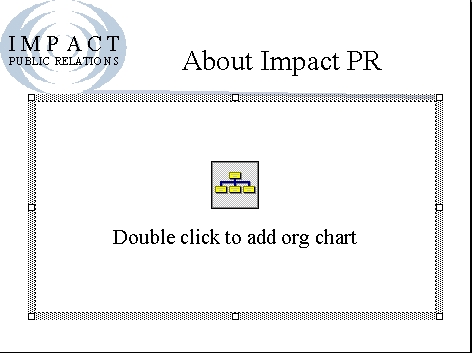
PowerPoint launches Organization Chart
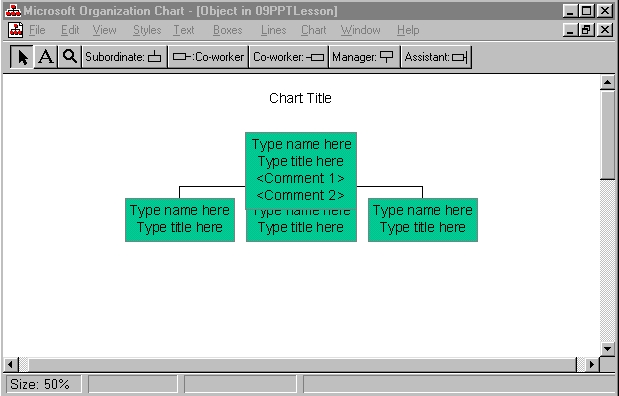
Type John Tan, MD
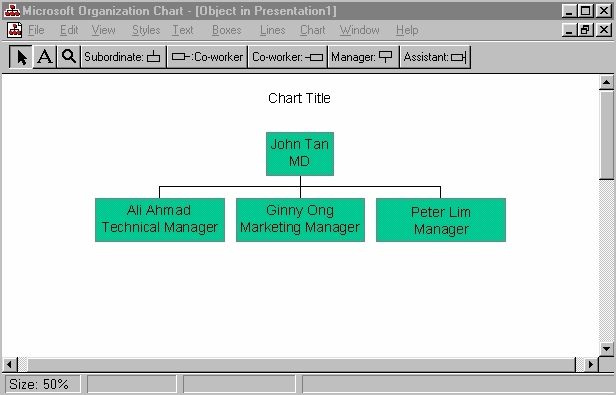
Type the rest of organizational structure
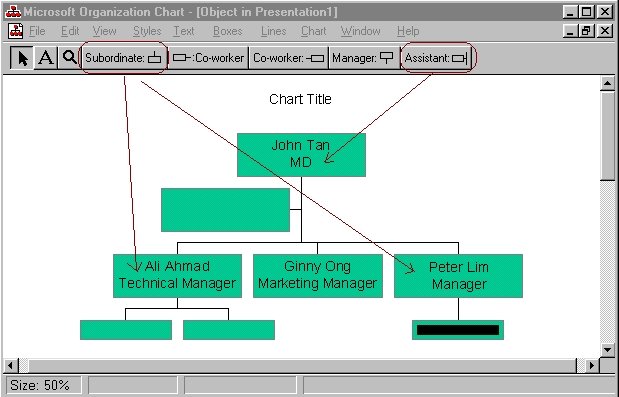
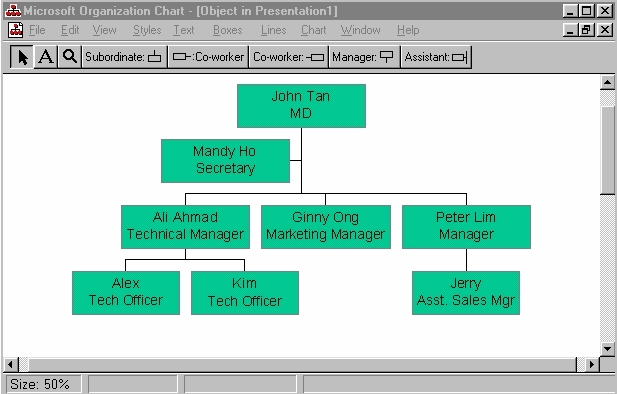
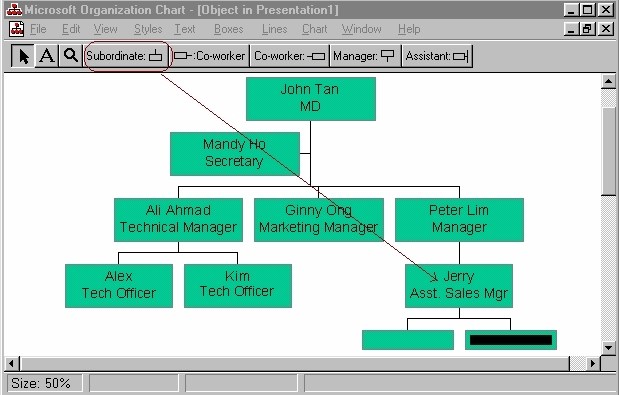

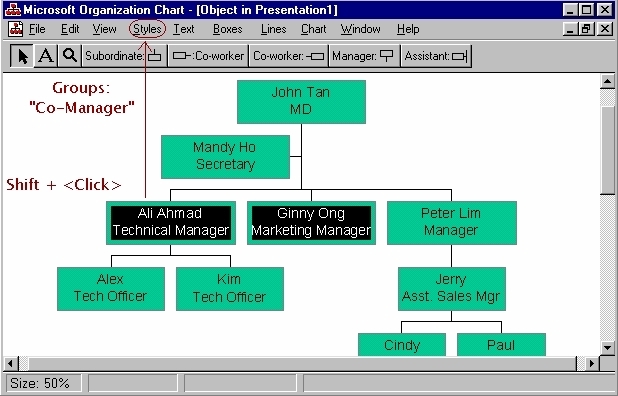
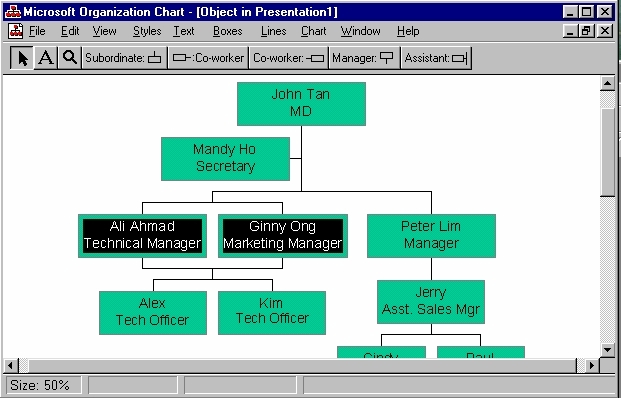
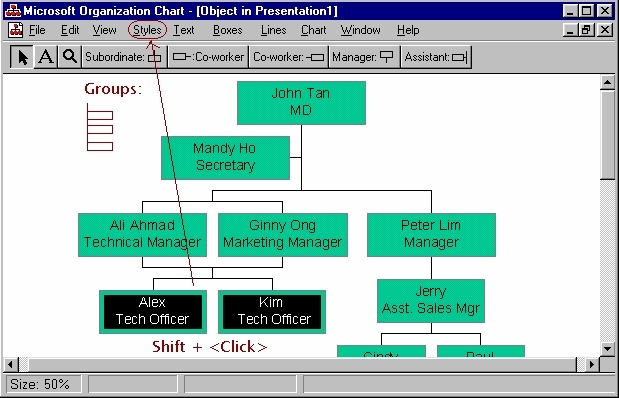
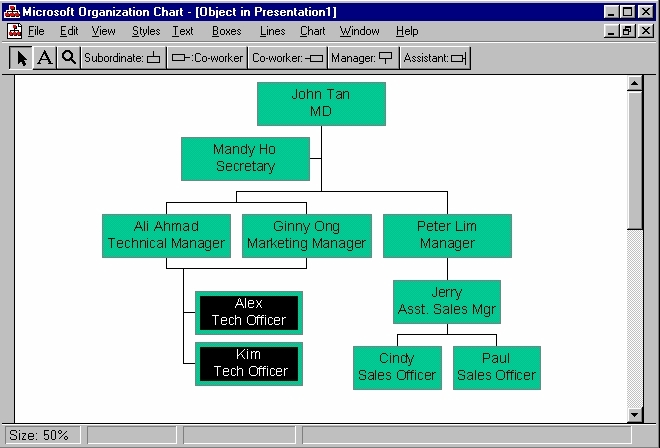
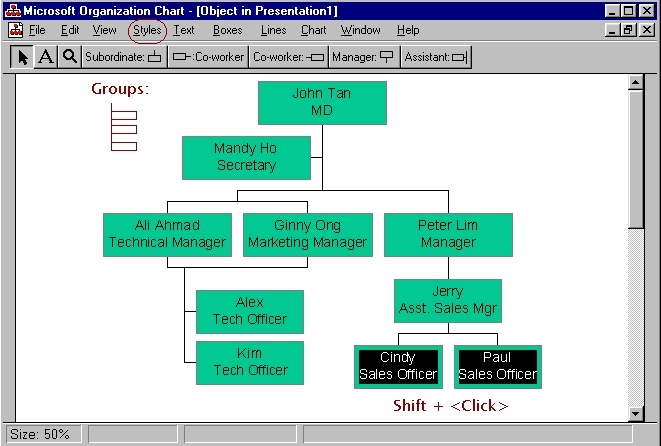



Use
Draw Tools on
organization chart
Click
<View>
<Show Draw Tools>
When
finished,
Click <File>
Select <Update
Presentation>
Click
<File>
Select <Close
and Return to Presentation>
Practice
Exercise 2
Continue Project 1.ppt
Review Exercise :


 Edwin
Koh : We
completed on the
Edwin
Koh : We
completed on the
New
Knowledge and Skills in
MS
PowerPoint 2000 Topic 4.















